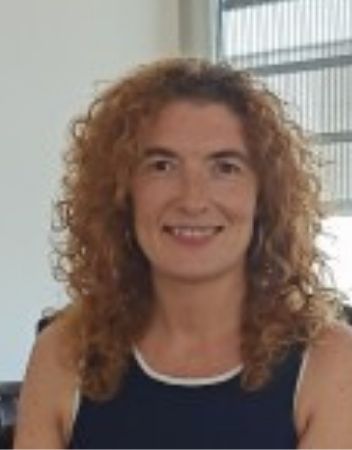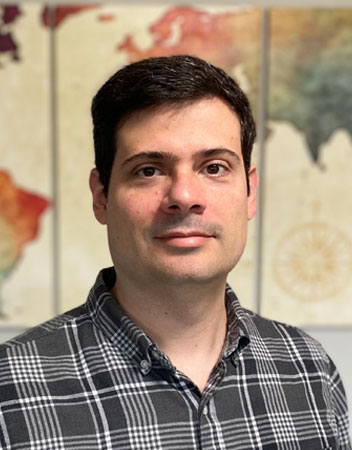Plenárias
Speakers

Martin Haardt
Martin Haardt
Martin Haardt has been a Full Professor in the Department of Electrical Engineering and Information Technology and Head of the Communications Research Laboratory at Technische Universität Ilmenau, Germany, since 2001. After studying electrical engineering at the Ruhr-University Bochum, Germany, and at Purdue University, USA, he received his Diplom-Ingenieur (M.S.) degree from the Ruhr-University Bochum in 1991 and his Doktor-Ingenieur (Ph.D.) degree from Munich University of Technology in 1996. From 1989 to 1990 he was a visiting scholar at Purdue University, West Lafayette, Indiana, USA, sponsored by a fellowship of the German Academic Exchange Service (DAAD). From 1991 to 1993 he worked for Siemens, Corporate Research and Development, in Munich, Germany, conducting research in the areas of image processing and biomedical signal processing. From 1993 to 1996 he was a research associate with the Institute of Circuit Theory and Signal Processing at Munich University of Technology, Germany, where his research was focused on smart antennas. In 1997 he joined Siemens Mobile Networks in Munich, Germany, where he was responsible for strategic research for third generation mobile radio systems. From 1998 to 2001 he was the Director for International Projects and University Cooperation in the mobile infrastructure business of Siemens in Munich, Germany, where his work focused on mobile communications beyond the third generation. He was appointed to a think tank of experts within the IST project WSI (Wireless Strategic Initiative). During his time at Siemens, he also taught in the international Master of Science in Communications Engineering program at Munich University of Technology. In 2018, Martin Haardt has been named an IEEE Fellow for contributions to multi-user MIMO communications and tensor-based signal processing. He has received the 2009 Best Paper Award from the IEEE Signal Processing Society, the Vodafone (formerly Mannesmann Mobilfunk) Innovations-Award for outstanding research in mobile communications, the ITG best paper award from the Association of Electrical Engineering, Electronics, and Information Technology (VDE), and the Rohde & Schwarz Outstanding Dissertation Award. He has participated in the European research projects FRAMES, WSI, WINNER, SAPHYRE, and EMPhAtiC as well as in the European Network of Excellence NEWCOM. Prof. Haardt has served as an Associate Editor for the IEEE Transactions on Signal Processing (2002 - 2006 and 2011 - 2015), the IEEE Signal Processing Letters (2006 - 2010), the Research Letters in Signal Processing (2007 - 2009), the Hindawi Journal of Electrical and Computer Engineering (since 2009), the EURASIP Signal Processing Journal (2011 - 2014), as a senior editor for the IEEE Journal of Selected Topics in Signal Processing (JSTSP, since 2019) and as a guest editor for the EURASIP Journal on Wireless Communications and Networking as well as the IEEE JSTSP. Moreover, Prof. Haardt has been instrumental in establishing and coordinating the international Master of Science in Communications and Signal Processing program at TU Ilmenau. His research interests include wireless communications, array signal processing, high-resolution parameter estimation, as well as numerical linear and multi-linear algebra.
Title: Gridless Channel Estimation for Hybrid MIMO OFDM Systems in the Millimeter Wave Band Using Tensor-Based High-Resolution Techniques
Summary: In this talk, we present a gridless channel estimation scheme for MIMO OFDM systems in the millimeter wave (mmWave) band that is based on R-D Unitary Tensor-ESPRIT in DFT beamspace. Compared to conventional ESPRIT based algorithms in element space, the beamspace approach can be applied to MIMO systems with hybrid architectures. Moreover, the proposed scheme significantly reduces the training overhead for communication systems operating in the mmWave band. The proposed procedure involves coarse and fine estimation steps. As one alternative for the coarse estimation step, Unitary Tensor-ESPRIT in element space may be applied to the array with a reduced size aperture to obtain initial information about the directions of arrival, the directions of departure, and the propagation delays of the dominant multipath components. Based on these parameters, a more accurate estimation of the angular profiles, propagation delays, and channel gains is performed in a second step by applying 3-D Unitary Tensor-ESPRIT in DFT beamspace in the spatial domains combined with the element space version in the frequency domain. We explain how to combine the received signals from different spatial sectors of interest and how to perform joint processing. The simulation results confirm the tensor gain of the proposed procedure in addition to an improved channel estimation accuracy.

Ana Isabel Pérez-Neira
Ana Isabel Pérez-Neira
Ana Isabel Pérez-Neira is a professor at UPC (Universitat Politècnica de Catalunya) since 2006. Fellow Researcher of CTTC with strong background in physical layer techniques for wireless communications and experience in European projects.Her research topic is signal processing for communications and currently she is working in multi-antenna and multicarrier signal processing, both, for satellite communications and wireless systems. She has been in the board of directors of ETSETB (Telecom Barcelona) from 2000-03 and Vicerector for Research at UPC (2010-13). She created UPC Doctoral School (2011). From 2008-2016 she has been member of EURASIP BoD (European Signal Processing Association), from 2010-2016 member of IEEE SPTM (Signal Processing Theory and Methods), from 2016-2018 she has been elected SPS Regional Director-at-Large. Currently she is member of the Board of Governors of IEEE Signal Processing Society and of the Technical Committee on SP for Communications. She is the coordinator of the European project SANSA and of the Network of Excellence on satellite communications, financed by the European Space Agency: SatnexIV-V. She has been the leader of 20 projects and has participated in over 50 (10 for European Space Agency). She is author of more than 60 journal papers (25 related with Satcom) and more than 200 conference papers (20 invited). She is co-author of 4 books and 5 patents (one on satcom). She has been guest editor in 5 special issues and associate editor of the IEEE Transactions on Signal Processing, EURASIP Advances in Signal Processing and Eurasip Signal Processing. She is the EURASIP liaison for Spain. She has been the general chair of IWCLD’09, EUSIPC’11, EW’14, IWSCS’14 and ASMS/SPSC’16, ICASSP2020 (with more than 15000 virtual attendees). Currently she is the Vice-President for Conference of the IEEE SPS. She is recipient for the 2018 EURASIP Society Award. She is IEEE Fellow.
Title: 3Dimensional communications in 6G: the non-terrestrial component
Summary: How do you imagine the future communication networks? Which are going to be their enabling new technologies: holographic arrays, quantum communications? Trying to answer these and related questions, researchers worldwide have begun to study new avenues, because the future networks are expected to be a wise combination of disruptive technologies and improved existing ones in 5G. Can you imagine a user centric network that you can activate whenever and wherever you are? A network with distributed intelligence and memory, that is able to transmit at terabits per second and to carry out fast computing over the air, in order to automate decisions and to enable a sustainable and always-best-connected network? You should not think only about big cities, but also about small villages, ad-hoc communities, oceans, … Such a vision is only possible if terrestrial and satellite communications become just one. We are most familiar with terrestrial radio communications, but what about satellite communications? When and where are they used? How do they operate? This chapter digs into these questions and brings satellite communications (satcom) closer to the reader with a combination of tutorial description and new avenues for research. First, the chapter will explain the key role of satcom in the origins of digital communications. The differences with terrestrial radio communications will also be described. Next, the key technologies at the physical and access layer are detailed. This will pave the way towards a new communication paradigm that allows terrestrial and satellite segments to better integrate into a 3D network.

Cláudio da Silva
Cláudio da Silva
Dr. Claudio da Silva is a Wireless Systems Engineer in the Reality Labs group of Meta Platforms (formerly Facebook) and is responsible for the standardization of wireless connectivity technologies and for advancing Meta Platforms’ spectrum policy strategy. He also serves as the Technical Editor of IEEE 802.11bf (WLAN Sensing), a task group currently developing an IEEE 802.11 amendment that enhances Wi-Fi sensing technology, and as an IEEE ComSoc Distinguished Lecturer for the 2022-2023 term.
Before joining Meta Platforms, Dr. da Silva was with the Next Generation & Standards group of Intel Corporation, where he was responsible for driving technology and product innovation by leading and contributing to various standardization, certification, and regulatory activities. During his tenure at Intel, he served as the Technical Editor of Wi-Fi Alliance's 60 GHz TTG from 2019 to 2021. Before Intel, he worked on cellular modem implementation and applied research at Samsung Mobile Solutions Lab. The first years of his professional career were spent at Virginia Tech, where he was an Assistant Professor in the Bradley Department of Electrical and Computer Engineering.
Dr. da Silva received the B.S. and M.S. degrees from the State University of Campinas, Brazil, in 1999 and 2001, respectively, and the Ph.D. degree from the University of California, San Diego in 2005, all in electrical engineering. He was an Editor for Modulation and Signal Design for the IEEE Transactions on Communications from 2012 to 2015, and is currently serving as a Guest Editor for the IEEE Communications Magazine. For the 2022-2023 term, he is serving on IEEE ComSoc’s Standardization Programs Development Board and Industry Outreach Board. He has served on the technical program committee of numerous IEEE conferences in the communications area. He is a Senior Member of the IEEE.
Title: The IEEE 802.11 standard and its constant evolution to meet new demands
Summary: The importance of technologies based on the IEEE 802.11 standard to our society cannot be overstated. For example, Wi-Fi, one of such technologies, has been the leading wireless connectivity technology used in homes and businesses around the world for more than two decades, and it is estimated to carry about 60% of the world’s mobile traffic today. As the use of wireless connectivity continues to increase and evolve, the IEEE 802.11 standard is constantly evolving to meet new demands, such as improved performance in dense environments and consistent ultra-low latency data transfer. In this keynote talk, we explore current work on future generations of the IEEE 802.11 standard, with emphasis on the main driving forces behind the standard evolution along with new features being considered. We will also discuss the IEEE 802.11 Working Group and efforts to add functionality to IEEE 802.11 technology by extending its use to positioning and sensing applications.